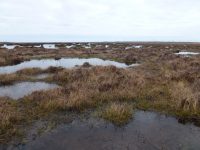A blog by Deborah Long, LINK Chief Officer
On 31 May, Francesca Oswaska, CEO of Scottish Natural Heritage, gave the RSE Peter Wilson lecture: Not too late to act for climate change. In her speech she described the challenging yet opportunity rich moment we find ourselves in.
At LINK we would agree with the three challenges that Francesca outlined on harnessing science, engineering and technology, changing land, water and sea management and shifting behaviours, but we think we need to act quickly.
Given that we have 11 years to realign the world along a low carbon pathway in order to avoid dangerous climate change, recent events underline how much public support there is for real action on this, especially from young people. We have evidence on climate change from the UKCC Net zero report and the IPBES Global Assessment of Biodiversity starkly outlines the ongoing and catastrophic decline in biodiversity. Francesca made the clear case that a nature rich future provides our best insurance cover against the climate emergency.
The Scottish Government has already acted in declaring a climate emergency and lodging amendments to the climate change bill to achieve greenhouse gas emissions of zero by 2045. However, climate change is just one of five drivers of biodiversity loss – the others are changes in land and sea use; direct exploitation of organisms; pollution and invasive non-native species. Albeit climate change is a driver that intensifies and exacerbates the effect of the other four. An example is that climate change is reducing the persistence of year-round snow, which is directly limiting the extent of arctic habitat in Scotland.
Nature based solutions clearly offer us the best and quickest way forward. There are immediate actions that could have a significant impact: ensuring the next climate change plan includes and supports the roll out of nature based solutions such as increasing the ability of Scotland’s peatlands, woodlands, seas and waterbodies to sequester carbon, strengthening the Land Use Strategy and introducing regional land use planning, delivering a National Ecological Network and developing a nitrogen balance sheet.
On land, water and sea management for example, while Scotland can do much more on peatland restoration, the UKCC net zero report recommends releasing 20% of agricultural land for carbon capture and biomass production. Of the 73% of land registered as agricultural holdings, about 36% of this is rough grazing. Reducing grazing pressure and enabling woodland regeneration in this 36% would make a significant contribution to Scotland’s carbon capture and would contribute to reversing the decline in habitat quality and biodiversity loss in the Scottish uplands.
Changing how we manage land, water and seas is only effective where that change is carried out in the right place. And to ensure that the right place is managed for its best purpose is where an actively implemented and effective Land Use Strategy comes in. However, this on its own is not enough. For Scotland to meet the climate emergency and halt the loss of biodiversity, nature needs space too. A National Ecological Network provides a strategic planning tool for the natural environment to enhance connectivity between habitats, give communities better access to high quality, wildlife rich greenspace, provide opportunities to protect and enhance natural capital and improve the range and quality of ecosystem services whilst at the same time making Scotland a more attractive place to live, do business, invest and visit. It is also the most efficient way of ensuring that nature thrives and is woven though our land and sea use. The current approach is nature being left the bits no one else needs is directly resulting in the declines we are seeing and are reported by IPES.
A key part of this are Scotland’s Protected Areas: these are effectively the refuges where nature is doing best and from where nature can spread back into suitable habitat given the space and means to move. Scotland’s current Protected Areas need to be retained, effectively monitored so we can see how the nature is doing, buffered and protected from adverse impacts and connected to the wider landscape though the provision of space and vectors species need to move, be that wind, water or the presence of micro habitats. As they stand today, Scotland’s protected areas are in aspic – constrained, uninvested in and as ecological processes march on, changing sometimes for the better but not always. In the face of climate change, these refuges are needed more than ever for the role they will have to play in boosting the nature based solutions we will need to adopt.
None of this can happen without investment though. The environment sector can offer the range, scale and innovative solutions Scotland needs to address the climate and biodiversity emergencies we currently face. LINK members are working together and with stakeholders to ensure that efficiencies of scale and appropriateness of action are maximised but the low levels of support for nature and landscapes from private funding success outlined in Where the green grants went and the ongoing decline in public funding for nature are insufficient. For too long, nature has been taken for granted and the external costs of resource use and depletion are not being paid. New ways of funding nature based solutions are urgently needed. It is clear that nature is not an added extra and a luxury for those who use the outdoors: nature provides the fundamentals of life for all in Scotland. But it cannot be protected and restored for free.

